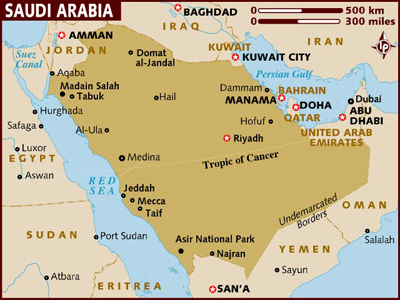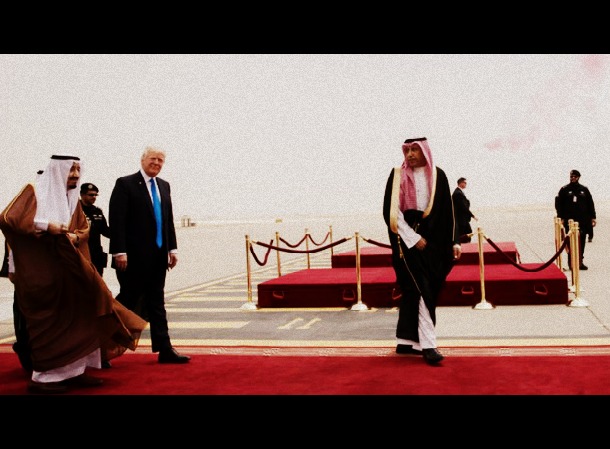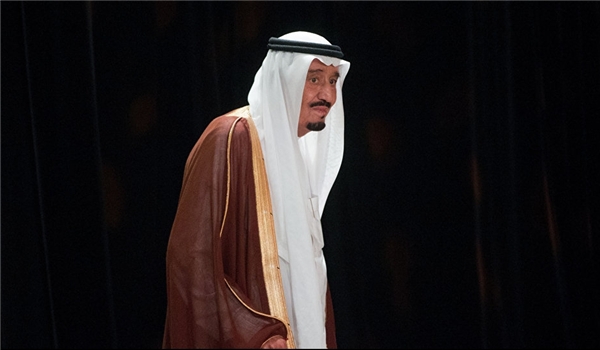
Andrew Korybko
21st Century Wire
Experts all across the world are trying to figure out what’s really fueling the Qatari-Saudi Cold War, but the answer is simple – the US. As it’s always prone to do, Washington is masterfully playing a game of divide and conquer in the Mideast, doing the same thing to its Gulf allies as it did to its North African ones during the theater-wide “Arab Spring” Color Revolutions, except this time pitting them against one another on a state-to-state level as opposed to an intra-state one between the government and some of its citizenry.
The long-term purpose behind all of this is to usher in Ralph Peters’ 2006 “Blood Borders” blueprint for the “New Middle East”, wherein the Gulf eventually undergoes a geopolitical reengineering just like “Syraq”, Turkey, and the Balkans are slated to do as well. All in all, the fracturing of the region into a myriad of internationally recognized and de-facto statelets is expected to facilitate the prolongation of American hegemony in the broad interconnected space that the late Brzezinski described as the “Eurasian Balkans,” while simultaneously creating major complications for its Russian and especially Chinese rivals’ access to this geostrategic pivot space at the heart of Afro-Eurasia.
That’s a lot to digest all at once, so let’s break everything down piece by piece so that it’s easier to understand.
“Little Machiavelli”
First off, the Qatar-Saudi Cold War was sparked by the mischievous workings of what the US military once called “Little Sparta”, the UAE (United Arab Emirates), which can nowadays be described as a “Little Machiavelli”. The Hotmail account of the Emirates’ Ambassador to the US was recently compromised and it reveals that Mr. Yousef al-Otaiba has been working overtime to destroy Qatar’s reputation in the eyes of influential American decision makers.
Abu Dhabi has been in a fierce rivalry with Doha since the turn of the century as the two ultra-rich Gulf States compete with one another to court the largest amount of foreign investment and become the ultimate “to-go” destinations in the Mideast. Moreover, the two countries are also engaged in a proxy war in Libya, where the UAE backs General Haftar’s Tobruk government whereas Qatar is behind Muslim Brotherhood factions in Tripoli.
Doha’s sponsorship of the Muslim Brotherhood – which is designated as a terrorist organization by GCC members the UAE and Saudi Arabia, Gulf-ally Egypt, and also Syria and Russia incidentally – has long been the bane of regional distrust within the Riyadh-led “Council of Kings”, and intra-organizational tensions reached a boiling point all throughout 2014 but were finally resolved by the end of the year. During that time, Doha promised to radically downscale its support for the Muslim Brotherhood, but it apparently never fulfilled its promise. Even so, none of the GCC members seemed to care too much until just a few weeks ago, which means that something else must have triggered this major Gulf Crisis.
Accepting that the UAE leaks are true and that its Ambassador to the US is indeed doing all that he can to besmirch Qatar, then it’s very likely that Abu Dhabi hatched a plan to “kill many birds with one stone” earlier last month. The Emirate brokered a de-facto peace deal between the two main sides in Libya’s Civil War at the beginning of May which essentially quashed Qatar’s chances of taking over the country by proxy.
This fragile agreement was nearly sabotaged shortly thereafter by “rogue” troops from the UN-backed government who opened fire on Haftar’s forces at an airbase in southern Libya and killed 141 of them. Nearly a week later, Libyan-based terrorists slaughtered 29 Coptic Christians in Egypt and prompted Cairo to take decisive action by ordering airstrikes against their camps across the border. Taken together, and considering that Qatar is clearly on the losing side of the Libyan Civil War nowadays, the UAE may have found it convenient to pin the blame for both the Libyan and Egyptian terrorist attacks on Qatar, and the timing couldn’t have been more perfect.
The Trump Factor
US President Trump visited Riyadh in the time between both attacks and urged the 50+ Muslim leader attendees to “drive out” the terrorists among their ranks. Apparently, Qatari Emir al-Thani had earlier given an unpublicized speech at the event where he spoke out against the “Arab NATO’s” increasingly obvious anti-Iranian agenda, but this allegedly was supposed to have been kept under wraps in order to avoid debunking the myth of Gulf unity.
Nevertheless, the very fact that the Qatari leader would dare speak in such a non-aggressive way about Iran in front of the infamously Iranophobic American President while being hosted in Saudi Arabia of all places made him the man that the “Arab NATO” decided to pin the blame on for Wahhabi terrorism all across the Mideast. Saudi Arabia would have probably invented a ‘pretext’ had one not fortuitously come up due to none other than Qatar itself just a week later when one of its public broadcasters reported on Emir Thani’s words in what must have been interpreted by the Saudis as one of the greatest humiliations against them in recent history.
Although Qatar quickly retracted the reporting and claimed to have been the victim of “hacking”, Saudi Arabia and its allies obviously didn’t believe it because they heard the country’s leader utter those very same statements about Iran and the “Arab NATO” that Qatar now claimed were fabricated.
This gave Riyadh the public cover for moving forward with its prearranged plans to make Doha the ‘fall guy’ for all of the Mideast’s problems, likely due to the advice being whispered in King Salman and his deputy crown prince Defense Minister Mohammed Bin Salman’s ear by the UAE, obsessed as they are to undermine their Qatari rival every step of the way.
The UAE already had an axe to grind with Qatar because of Libya, Egypt as is known totally despites the peninsular country for supporting former Muslim Brotherhood President Mohamed Morsi, and the Saudis will never forgive Emir Thani for speaking the way that he did about Iran while being hosted by the Kingdom.
From the UAE’s perspective, all the right pieces were in play for getting Saudi Arabia to marshal the GCC and its wider allies against Qatar, but Abu Dhabi – the “Little Machiavelli” that it is – ensured that Riyadh would do its bidding by making a personal appeal to the young Saudi Defense Minister.
Mohammed Bin Salman is widely regarded as the “mastermind” behind the disastrous War on Yemen which sapped so much of his Kingdom’s finances and prestige, and he’s clearly desperate for a “quick victory” which can help reclaim the carefully crafted perception among the Sunni community of Saudi hegemony in the Mideast. It wouldn’t be surprising to find out that UAE Ambassador to the US or one of his fellow Emirati “deep state” allies convinced the Defense Minister that a “quick campaign” against Qatar could not only achieve just that, but it would also help reshape the historical narrative about the Mideast by blaming all of its Saudi-inflicted woes on Qatar instead.
Additionally, the timing of events is such that ego-centric Trump could also take a piece of credit for this too, as he was more than eager to do on Twitter earlier this week.
Target: Iran
All told, the “Little Machiavelli” hatched the type of plan that would have made its medieval namesake proud. The UAE was able to get regional and confessional heavyweight Saudi Arabia to take the lead (and therefore, the blame if anything goes wrong) in marshalling some of the “Arab NATO’s” countries against Qatar in order to pin the blame for years of Wahhabi terrorism in the Mideast right on its leadership’s doorstep, obviously intending to initiate a game for keeps whereby the Kingdom either turns Thani into a puppet or outright deposes of him by prompting either a Color Revolution, Hybrid War, and/or royal coup against him.
The days of an LNG-rich Qatar thumbing its nose at the rest of the GCC and subsequently pioneering a somewhat independent foreign policy by patronizing the hated Muslim Brotherhood and pragmatically interacting with Saudi archenemy Iran could become history, and the fact that this “quick victory” could also distract from the disastrous War on Yemen was too tempting of an opportunity for King Salman and his gray-cardinal-Defense-Minister-son to turn down.
That being said, there are certainly risks inherent with enacting a de-facto embargo against Qatar and isolating it on the partial grounds that it’s becoming too close to Iran, and the most obvious of them is that this will become a self-fulfilling prophecy by driving Doha into Tehran’s arms.
The Islamic Republic already offered humanitarian aid to the peninsular emirate in the form of food supplies and said that it could make use of its airspace to get around the GCC’s embargo, which was clearly unacceptable for Saudi Arabia.
Just a few days later, Daesh carried out an unprecedented series of terrorist attacks against the Iranian parliament and Ayatollah Khomeini’s mausoleum, which the country’s Islamic Revolutionary Guard Corps blamed on its Saudi rival who promised last month to take the regional proxy battle between the two to Iran’s home turf.
Evidently, Riyadh wanted to prevent a Qatari-Iranian Strategic Partnership from forming and potentially coalescing around a “gas OPEC”, but the Kingdom might have unintentionally made this an accelerated fait accompli so long as Emir Thani can hold onto power and doesn’t back down.
The Russian Red Herring
This entire episode was interestingly interrupted by the US’ ridiculous claims that Russian hacking was behind the revived Qatari-Saudi Cold War. It’s laughable that the American “deep state” establishment (the permanent military, intelligence, and diplomatic bureaucracies) feels the need to obsessively try to link everything that “goes wrong” in the world with Russia, but there might actually be a little something more to it this time around.
The author explained in his latest research article about “Russia’s Energy Diplomacy In The Mideast: Boom Or Bust?” that Russia has recently – and to the surprise of all but the most astute observers – cultivated very positive relations with its former Saudi and Qatari rivals, both of whom it ordinarily competes with in their respective oil and gas energy markets, but also in Syria as well. That state of affairs might be changing, however, since the author forecasted that Russia would be able to mediate between Saudi Arabia & Qatar and Iran & Saudi Arabia so long as it continues to maintain great relations with all of them.
In fact, about the first pair of rivals, President Putin even called Emir Thani earlier this week and the Russian leader himself was besought by Turkish President Erdogan a day before that over this very same topic too. Clearly, Russia was – and still is – on track to position itself as the ultimate neutral arbitrator in this spat, seeing as how it’s not a Muslim-majority country like potential mediators Turkey or Kuwait are, nor does it have any self-interest in taking sides among either of the two Wahhabi-exporting countries.
Additionally, given that the Saudis likely didn’t plot their terrorist attack in Tehran overnight and probably put some prior planning into it which involved some degree of American complicity or another, the US might rightly have predicted that Russia could be the only country which would have any feasible chance at preventing the forthcoming spike in sectarian tensions between the two antagonistic countries from boiling over into a hot war.
Accordingly, this prompted the US to try and attribute responsibility for the Qatari-Saudi Cold War – and by extent, the preemptive Saudi-supported terrorist attack in Iran – to Russia by cleverly giving Qatar a “face-saving” way out of this mess if only Emir Thani would bite the bait and blame the whole “misunderstanding” on Russian hackers.
The Gulf leader, however, seems to be much wiser than the Americans give him credit for, knowing that he’s indeed playing a game of keeps with Saudi Arabia and that he will either be deposed or make his country strategically powerless if he backs down and capitulates in the face of the Kingdom’s unyielding pressure.
As for Saudi Arabia, it also doesn’t seem to be too eager to advance the sloppy conspiracy theory of Russian culpability, especially since Qatar didn’t take the first step in this direction. Either actor might change their positions on this matter as time goes on, or this desperate American move might soon fizzle out and be forgotten about if neither of them gives it much attention.
Provided that the current trajectory on this sub-tangent continues, then Russia could eventually play a very important role in avoiding a larger conflict, much as it did nearly 4 years ago when it came to the US’ false flag chemical weapons attack in Ghouta and consequent run-up to war.
Saudi Arabia As The “Next Syria”
Russia is keenly aware of the US’ plans to “balkanize” the “Eurasian Balkans”, and it knows that this would be disastrous for the emerging Multipolar World Order. On the one hand, Moscow is both unable to completely stop some of the centrifugal forces that Washington already initiated and balks at the military commitment needed to delay them, which explains for example why it’s promoting Kurdish “decentralization” in the Russian-written “draft constitution” for Syria as a compromise to this pro-American group’s unilateral “federalization” attempt.
On the other hand, though, this obviously doesn’t mean that Russia is indifferent to the fragmentation process at large. How this relates to the ongoing Qatari-Saudi Cold War and the Wahhabi Kingdom’s utilization of Daesh proxy terrorists against the Islamic Republic is that Moscow believes that this is the American-provoked external catalyst needed to initiate the irreversible but potentially long-term processes of state dissolution in this part of the Mideast just like what happened in North Africa and “Syraq” over the past six years. Bearing in mind that the Mideast’s two most religiously influential states are directly involved this time around, the geopolitical consequences could shatter the balance of power in Eurasia.
The author explained Iran’s structural Hybrid War vulnerabilities in his summer 2016 article about “The US-Saudi Plan To Prompt An Iranian Pullback From Syria”, which focused on how Daesh, the Baloch, Kurds, Arabs, and Azeris could all be leveraged within Iran’s borders as tools to undermine the state and induce desired concessions from its leadership, so the reader should review that analysis if they’re unfamiliar with these concepts.
As for Saudi Arabia, its sectarian leadership provoked serious Shiite unrest in the oil-rich Eastern Province after carrying out state-sponsored oppression against its confessional minorities. A similar scenario is slowly unfolding but isn’t yet imminent in the southwestern part of the Kingdom along the Yemeni border in Shiite-majority areas which used to be part of its neighbor prior to the 1934 Treaty of Taif that ended the Saudi-Yemeni War. It’s therefore not without cause that the majority-Shiite Houthi national liberation group regularly targets Saudi military positions in this part of the country. Finally, the last main structural vulnerability in Saudi Arabia is the royalist divisions over crown prince and grey cardinal Mohammed Bin Salman.
The Defense Minister and aspiring king is doubly hated by some in the monarchy for the self-inflicted financial and reputational wounds to his country brought about by his decision to launch the War on Yemen, and also for his internal “reform” (in a relative sense) agenda of Vision 2030 which aspires to modernize the economy into a real-sector one and away from its oil-exporting dependency.
If his signature domestic project is carried out to its full extent, then it could initiate piecemeal socio-cultural changes which provocatively go against the hardline Wahhabi teachings of the Kingdom’s influential clerical class. Many observers were too busy (rightly) talking about Saudi Arabia’s many foreign policy follies to notice the one thing which it “did right”, and that’s strengthen its relations with China to the level of a de-facto strategic partnership during King Salman’s visit to the People’s Republic earlier this spring.
The author wrote about the significance behind this event and the reason why China signed over $65 billion dollars of deals with the Wahhabi Kingdom in his piece for The Duran titled “Why is China choosing to partner with Israel and Saudi Arabia?”, but the pertinent point comes down to the fact that “China Chases Markets In The Mideast”.
What’s meant by the author’s cited article from last fall is that China’s One Belt One Road (OBOR) global vision of New Silk Road connectivity envisions the GCC playing a pivotal role in the larger paradigm as Beijing builds factories and railroads in the region in exchange for the Kingdoms investing some of their copious cash in the People’s Republic for the ultimate win-win outcome. In fact, the successful pairing of Mohammed Bin Salman’s Vision 2030 with China’s OBOR could lead to the moderation of Saudi Arabia’s sectarian-centric regional foreign policy if the influence of the clerics is diluted as a result, and this in turn could seriously increase the prospects for a multipolar Mideast.
The author wrote about this and even mapped out the many interlinked New Silk Road corridors which could realistically sprout from this new regional dynamic in his piece titled “Eurasianism: How A Better Mideast Would Look” from last fall, and the reader should certainly skim through it to get a clear picture of why Russia is so strongly opposing the US’ “Blood Borders” blueprint in the “Greater Mideast” and believes that even the troublesome Gulf is worth saving in terms of how it relates to the “bigger picture” of promoting multipolarity all throughout the supercontinent.
All of this, however, could be jeopardized if Qatar & Saudi Arabia and Iran & Saudi Arabia enter into an existential proxy struggle within their rival’s borders and turn the Wahhabi Kingdom – among other countries – into the “next Syria”.
Concluding Thoughts
The US is intent on destabilizing Afro-Eurasia in order to more easily control the Eastern Hemisphere by proxy, hence why it’s recently resorted to the combined approach of employing Hybrid War alongside its “Lead From Behind” regional strategy of local lackeys in order to bring this about.
Although all of the involved parties in the current Gulf Crisis stand to experience multilaterally beneficial gains if they can peacefully contain themselves long enough to reap tangible dividends from China’s OBOR projects, the unfortunately reality is that regional dynamics and the history of distrust between several sides means that the US can more easily manipulate them all into a Hobbesian asymmetrical conflict against one another.
The UAE, also known as “Little Machiavelli”, is playing a key role fanning the flames of conflict via its masterful intrigue because it envisions itself receiving the US’ blessing in becoming the post-fragmentation consolidating force in this part of the “Eurasian Balkans” due to its unique nature in being a collection of separate emirates. From the American perspective, the UAE could become a pivotal center of gravity after the Mideast is redrawn with “Blood Borders” (likely adjusted from the frontiers that Ralph Peters originally had in mind 11 years ago due to changed circumstances in some areas) because it could exert centripetal influence in amalgamating some of the post-Saudi emirates left over in the wake of the Kingdom’s collapse. With this in mind, the UAE’s plans look especially cynical because it’s basically setting up the Saudis to fail in order to replace their regional role when the dust settles.
Russia and China are well aware of what’s going on, however, since they wised up a few years ago during the US’ coordinated proxy assaults against each of them in Ukraine and the South China Sea in realizing that their chief geopolitical rival will wield the weapon of Hybrid War in trying to sabotage their 21st-century competitive connectivity projects in a desperate attempt to indefinitely prolong the fading “unipolar moment”.
For this reason, both Eurasian Great Powers are especially concerned about the US’ latest efforts to manipulate the Gulf States and Iran into a self-perpetuating cycle of destabilizations against one another as it attempts to trick them in turning the “Blood Borders” blueprint into a reality. Regrettably, Saudi Arabia is much too gullible and easily guided in the direction of the US’ grand strategic interests, so it’s uncertain at this time whether the warned-about scenario can still be avoided.
Nevertheless, the US certainly thinks that Russia stands the best chance of anyone at stopping its plans, which is why it tried to destroy its recent reputational gains in the Gulf by accusing it of “hacking” Qatar and therefore instigating the whole crisis. The fact that neither Doha nor Riyadh have bit the bait, or at least not yet, leaves hope that Moscow might be able to use its positive relations with both countries and neutral status between them to mediate a peaceful solution to the first stage of this spat, and then possibly expand upon its gains to ease the aggravated tensions between Saudi Arabia and Iran.
It’s admittedly an ambitious task, and one which definitely doesn’t have any guaranteed chance of achieving even the most modest symbolic success, but it’s still Russia’s – and to an extent, also China’s – geopolitical responsibility as one of the dual engines of Eurasian integration and the emerging Multipolar World Order to at least exert its best behind-the-scenes efforts in trying before it’s too late.
***
DISCLAIMER: The author writes for this publication in a private capacity which is unrepresentative of anyone or any organization except for his own personal views. Nothing written by the author should ever be conflated with the editorial views or official positions of any other media outlet or institution.
FOR MORE MIDDLE EAST NEWS: 21ST CENTURY WIRE MIDDLE EAST FILES
SUPPORT 21WIRE – SUBSCRIBE & BECOME A MEMBER @21WIRE.TV



















